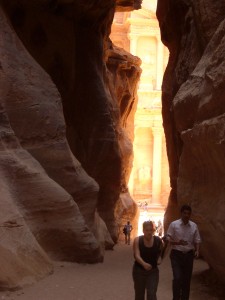The Trouble with 7 Wonders
by Heather Pringle
October 24, 2008
 I’ve just returned this week from a crazy, whirlwind trip to Jordan, where I toured for the first time the stunning ruins of Petra. As many of you may know, Petra is one of the marvels of the ancient world. Exquisitely carved and chiseled from looming sandstone cliffs, this well-defended city was the capital of the Nabateans—nomadic Arab traders who seem to have arrived in the region during the 3rd century B.C. Gradually wresting control of the caravan traffic in spices and incense, the Nabateans racked up a fortune that they invested in Petra’s architecture —some of the most beautiful tombs, temples and houses I’ve ever seen.Â
I’ve just returned this week from a crazy, whirlwind trip to Jordan, where I toured for the first time the stunning ruins of Petra. As many of you may know, Petra is one of the marvels of the ancient world. Exquisitely carved and chiseled from looming sandstone cliffs, this well-defended city was the capital of the Nabateans—nomadic Arab traders who seem to have arrived in the region during the 3rd century B.C. Gradually wresting control of the caravan traffic in spices and incense, the Nabateans racked up a fortune that they invested in Petra’s architecture —some of the most beautiful tombs, temples and houses I’ve ever seen.Â
I will be writing about Petra and an ingenious project there in a future blog and in an article that will appear in Archaeology magazine next spring, but I want to pass on some interesting rumblings of dissatisfaction I heard during my visit.  These were directed toward the organizers of the “New 7 Wonders of the World†campaign.
I’m sure that you will remember this glossy international competition. In September 2000, an entrepreneurial Swiss-born Canadian, Bernard Weber, a former film-maker turned heritage activist, announced a plan to name the New Seven Wonders of the World. Weber observed that there had never been “any true public consensus of opinion on the last 2000 years of human achievement.â€Â So he set up a foundation and designed a slick internet site where people around the world voted on the ancient sites to be included in the “New 7 Wonders of the World.† Weber and his associates received 100 million votes, and last July they unveiled their list in a lavish day-long ceremony hosted by Hilary Swank and Ben Kingsley in a Lisbon stadium. Â
The New 7 Wonders Foundation promised on its website to donate 50% of its net revenues to document and conserve ancient monuments globally. It planned to raise money by several means—selling ad space on its popular website; licensing its concept; and hawking TV, DVD, online and mobile rights to its New 7 Wonders Official Film. So you might think that part of these proceeds have now flowed back to Petra, an archaeological site that faces severe conservation problems. But you would be wrong.  When I spoke with the director of Petra National Archaeological Park, Suleiman Fujeirat, he seemed unaware of any money that had come to the park through the New 7 Wonders Foundation. And when I checked online later, I discovered that Weber himself conceded three months ago that New 7 Wonders had just broken even—making only enough to cover costs.
Now here’s the rub. As a result of all the New 7 Wonders hoopla and publicity, tourism has soared at Petra. In 2006, before the announcement, the UNESCO World Heritage Site hosted 364,000 visitors: this year, from January to mid October alone, more than 600,000 tourists flocked to the park, exceeding the limits that UNESCO had recommended by 20%.  I find this worrying. Heavy tourist traffic is daily endangering the millennia-old monuments, damaging the fragile facades of the buildings. And Jordan, being a poor country flooded with Iraqi refugees, has little spare cash for archaeological conservation.  Â
Petra’s director politely declined to criticize the New 7 Wonders campaign, perhaps because Jordan’s queen publically supported it. But others I have talked to are not so diplomatic. The New 7 Wonders may have started out as a very cool idea. But at Petra, it seems to have created more headaches than it cured.
Comments posted here do not represent the views or policies of the Archaeological Institute of America.






 Heather Pringle is a freelance science journalist who has been writing about archaeology for more than 20 years. She is the author of Master Plan: Himmler's Scholars and the Holocaust and The Mummy Congress: Science, Obsession, and the Everlasting Dead. For more about Heather, see our
Heather Pringle is a freelance science journalist who has been writing about archaeology for more than 20 years. She is the author of Master Plan: Himmler's Scholars and the Holocaust and The Mummy Congress: Science, Obsession, and the Everlasting Dead. For more about Heather, see our 



